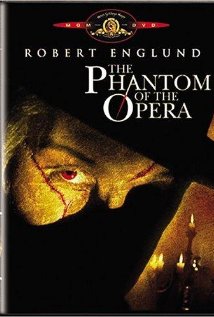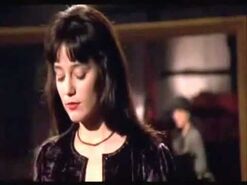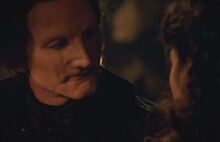
The Phantom of the Opera (1989) is an American horror film based of the Gaston Leroux’s novel of the same name. It also uses elements of Charles Gounod’s opera Faust. Dwight H. Little directed the film while Gerry O’Herra and Duke Sandefur wrote the screenplay. The film is a bloody adaptation of the novel. It holds a 38%” Rotten” rating on Rotten Tomatoes and was a failure at box office only making 4 million dollars. A sequel was planned, however, it was cancelled after the poor reception at box office.
Synopsis[]
The scene opens in present day Manhattan where Christine Day meets with her accompanist, Meg, to find music for the next audition. Meg discovers Erik Destler’s unfinished opera, Don Juan Triumphant. While auditioning, Christine is hit with a sandbag falling from the rafters and is rendered unconscious. When she awakes, it’s 1889 and she is lying in the London Opera House.
Christine is shown to her room after a Joesph Baquet blames a spirit for the dropping of the sandbag. Alone, her "Angel of Music" visits her and tells her that she will be playing Marguerite in tonight’s performance. The scene pans to Carlotta’s dressing room. She demands for Christine to return to the chorus. She then finds the skinned body of Baquet in her closet and doesn’t sing.
While the Phantom attends the opera in his usual box, he flashbacks to the deal he made with the devil. Everyone will hear and love his music, however, his face has been disfigured and burned. Christine sings beautifully and receives a standing ovation. After the show, Christine goes to dinner with Richard. The next morning, the reviewer gives her a terrible review and she goes to the grave of her father where she meets with the Angel of Music, playing a lullaby on the violin, and goes with him to his lair. Erik shows her his unfinished Opera and Christine sings the words. Afterwards, he places a ring on her finger and binds their souls. He demands that she cannot see any other man. When Christine returns, she gives Ricard a note telling him to meet her at the masquerade ball.

At the ball, Christine and Richard meet up and she attempts to tell him everything. Erik is there and murders Carlotta. He then kidnaps Christine and Richard uses one the the stage hands to discover the lair. At the Lair, Erik tries to make Christine marry her. Richard attempts to rescue her, Erik murders her and he burst into flames. Christine falls into the pit after him.
Back to the present, Christine awakes to discover she has received the part from the producer, Mr. Faustus. At his apartment, Christine realizes that Faustus is the Phantom and destroys his music to destroy him. While leaving, Christine hears the phantom’s lullaby on a violin.
Themes[]
Horror[]
Like the novel, this film is rooted in the horror of the phantom. This phantom is very monstrous and aggressive from the beginning of the adaptation. Erik murders Joesph Banquet and skins him. He uses the bloody bodies as ways to scare Carlotta out of singing. He beheads Carlotta and places it in the soup. He murders the theatre critic in a sauna. These deaths are very violent and add to the horror of the gothic film.
The horror motif travels into the present world. Christine finds the Phantom’s Opera and as she sings the words, blood pours out of the book. It not only signifies that the Opera is haunted, it adds to the gore and mystery of the novel. It is never addressed why the blood appears. However, it reflects the ever lasting deal that Erik has with the devil and in order to kill Erik, one must destroy the music.
The phantoms grotesque appearance adds to horror of the film. The phantom uses skin from others as well as stage makeup to cover his scars. His burned appearance terrifies everyone. The stronger he loves, the more grotesque his appearance becomes. Eventually, He must wear a mask to cover his disfigurement. In the present day timeline, Christine tears away the mask of human skin and his face is rotten and black. The horror exists throughout both timelines.
Hauntedness[]
Like the novel, This film is haunted by the presence of the Phantom. The Phantom haunted the opera house, moving within the crew members as well as the cast mates to do his bidding. He whispers to Christine and makes her believe that he is the Angel of Music. The past life plot follows much of the haunted examples and themes of past adaptations.
The films ends the movie in the overall sense of hauntedness. The present day Christine is haunted by her past life. The overall present world is haunted by that past world. Each of the main characters are doubled in the past life. It gives an overwhelming sense that the events of the past are going to replay in the present. After Christine murders the phantom in the present, She walks away and hears the phantom’s lullaby he plays to her in the past plot. It leaves the sense that the monster will never die and allows the Phantom to continue haunting the rest of the world.
Meta-theatricality[]
This adaptation of the Phantom becomes self-referential. While the phantom watches the performance of Faust, he begins to remember the deal that he made with devil. The phantom becomes a Faust-like character and as a result, the plot of the movie begins to unfold similar to the plot of the opera.
Much like Faust, the Phantom can only admire Christine and never fully have her. In order to be with Christine, the Phantom would have to repent and give up the ability for anyone to listen to his music. The phantom cannot repent and as a result can never be with Christine.
The meta-theatricality continues not only with the character but with the dual timelines. The present timeline becomes a replay of the past timeline. The plots reflect upon each other and comments on the idea of a play being acted within the present day realm. The meta-theatrically eventually haunts the film because of the idea that the phantom’s lullaby at the end of the play. The lullaby allows for the concept that the monster is still out in the world. With this idea in mind, the film comments on the idea that this plot will continue on and replay itself out again.

Appearence vs. Reality[]
Like the other adaptations, Appearance and Reality dominates this film as well. The entire past timeline begs the question if it is really happening. We are not quite sure if it is just the appearance of the past life or if it was truly being played out with the American Christine.
The phantom is constantly sewing on pieces of skin to his face, protecting the truth from the world. The phantom created an appearance for Christine to win her over, when reality is that He is a truly horrific phantom. Erik appears to the world as a normal person, however, the show makeup and skin is what protects him from the reality of the horror.
Another demonstration of appearance vs. reality in the play is through the masquerade ball. Each of the characters hide under a mask. Christine must appear to be someone else to protect herself from reality and hide from the phantom. However, her disguise did not protect her.
Appearances continue into to the present time line. The phantom wears a mask to protect his image and waits for a reincarnation of Christine. He takes on a persona of a producer to continues within the theatre. When Christine removes the skin, the reality that the past plot is impending on the present timeline. Erik must keep up appearances to eventually reveal the real it of the situation.
Importance of Adaptation[]
The is one of the first adaptations to directly reference the Phantom as a Faust-like character and creates flashbacks to live in those moments.
The dual time lines enhances the haunted feel and reflects the stage version musical by Andrew Lloyd Webber. Raoul remembers the events of the opera, and here Christine is reliving those events in the memory and present tense.
This is the first phantom that is purely horrific. He doesn’t wear a stage mask but uses human skin from his murders to protect his face. His disfiguration occurs because of a deal he made with the devil, reflecting the 1943 origin story idea.
This is one of the first adaptations that shows horrific deaths and bloody scenes. It constantly is referencing itself though the reflection of the dual plot as well as comparison to the Faust opera
When returning to the past time line, Christine is an American actress performing in London. It is never clear why she is there, however, Christine is now singled out and alienated. She becomes more sympathetic to the phantom and the angel. Her alienation connects her to the Phantom who is alienated from the society.
